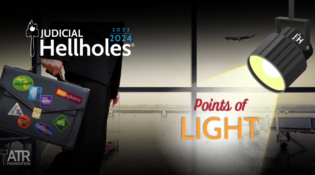PRESUMED GUILTY UNLESS FOUND INNOCENT
Justice Moulton and his chambers have made it abundantly clear that NYCAL defendants can never obtain summary judgment. He has effectively lifted the plaintiffs’ initial burden of establishing their case and has instead imposed on defendants the virtually impossible-to-bear burden of proving a negative – namely that that their product was not present at a claimants’ worksite when alleged exposure to asbestos occurred. In doing so, Moulton has established a standard unique to NYCAL, where plaintiffs need only make blanket, vague allegations of exposure in order to defeat summary judgment. Not a single defendant implicated by a plaintiff’s exposure allegations has ever been granted summary judgment in Justice Moulton’s courtroom, and the resulting threat of jury trials increases pressure on defendants to settle beforehand.
For example, Justice Moulton in March 2016 issued two troubling (and virtually identical) decisions against Utica Boilers, Inc. and Fulton Boiler Works, Inc. Mark Ricci, a mesothelioma claimant, alleged he was exposed to asbestos brought home on his father’s clothing. During a deposition, his father, Aldo Ricci, generally recalled observing contractors removing asbestos-containing insulation from the exterior of boilers when he worked as a draftsman engineer. On cross examination, Aldo did not remember observing anyone working on a Fulton or Utica boiler. When specifically asked whether he believed he came into contact with asbestos from a Fulton or Utica boiler, Aldo answered “No.” Nevertheless, Judge Moulton refused to dismiss the cases against those two companies.
Although Justice Moulton cited and claimed to rely on a prior New York court decision that held speculation and conjecture cannot defeat a motion for summary judgment, both of the Ricci opinions effectively do the opposite. Because both companies manufactured asbestos-containing boilers, Moulton considered Aldo’s testimony regarding his lack of exposure to asbestos from the defendants’ products to be a credibility issue for a jury’s evaluation. The court simply assumed that someone working as a mechanical engineer for many years “might reasonably be expected to come in contact” with asbestos-containing boilers made by Fulton and Utica, among others.
Two months later Justice Moulton reiterated in Koulermos v. A.O. Smith Water Products Co. that “[s]ummary judgment is properly denied even where the plaintiff does not believe the product contained asbestos.”
Most recently, in October 2016 Justice Moulton again denied summary judgment in DeMartino v. Aurora Pump. Co. Misstating one of the core concepts of a plaintiff’s burden in asbestos litigation, he proclaimed that “it is not plaintiff’s burden to make a prima facie showing that plaintiff was exposed to asbestos-containing products manufactured, sold, or specified by Aurora.” This short statement itself implies that merely suing a business not only permits a trial against that company, but also would allow a jury to find the company liable unless it can “prove the negative” by showing its product could not have contributed to the plaintiff’s injury.
In the same case Justice Moulton ruled that an affidavit submitted by a witness designated as the company’s “person most knowledgeable” about the product at issue may not be creditable if that witness’s employment did not overlap with the plaintiff’s alleged asbestos exposure. Since Justice Moulton refused to acknowledge the company’s witness with regard to product information pre-dating his employment, the defendant could not demonstrate that its pumps “could not have contributed” to plaintiff’s injuries.
The additional irony, besides the blatant disregard of the facts and evidence, is Justice Moulton has denied numerous motions for summary judgment on the very basis that the defendant did not provide an affidavit from the company’s “person most knowledgeable.” Given the latency period involved in asbestos related injuries, Moulton’s court has for all intents and purposes disregarded New York law and shut down summary judgment as a remedy afforded to NYCAL asbestos defendants.
 Arthur Luxenberg of Manhattan-based Weitz & Luxenberg, who exercise significant influence over judicial appointments through their involvement in judicial screening and departmental disciplinary committees. In fact, New York Governor Andrew Cuomo himself has sheepishly conceded that “[t]he trial lawyers are the single most powerful political force in Albany.”
Arthur Luxenberg of Manhattan-based Weitz & Luxenberg, who exercise significant influence over judicial appointments through their involvement in judicial screening and departmental disciplinary committees. In fact, New York Governor Andrew Cuomo himself has sheepishly conceded that “[t]he trial lawyers are the single most powerful political force in Albany.”




